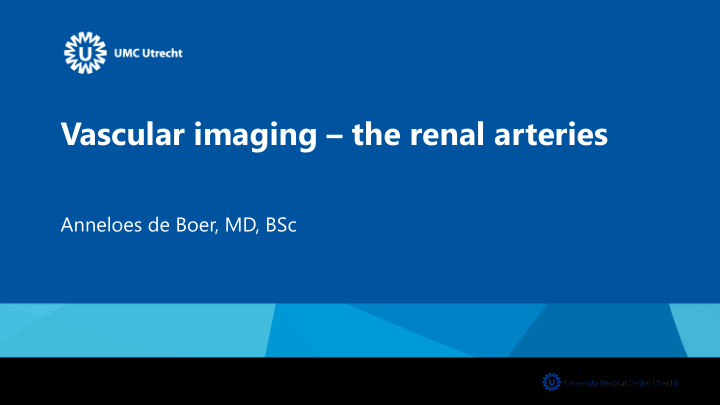



Vascular imaging – the renal arteries Anneloes de Boer, MD, BSc
Clinical rationale renovascular hypertension renal denervation renal transplantation
Clinical rationale renovascular hypertension renal denervation renal transplantation
Goldblatt phenomenon RAAS activation r enal blood flow ↑ sodium retention GFR (↑ ) blood pressure ↑ Goldblatt et al. J Exp Med. 1934 Feb 28;59(3):347-79.
Fibromuscular dysplasia Fabrega-Foster KE, et al. J Magn Reson Imaging. 2018 Feb;47(2):572-581.
References: Bax L et al. Ann Intern Med 2009;150:840 – 848; W150-841. Wheatley K et al. N Engl J Med 2009; 361:1953 – 1962. Cooper CJ et al. N Engl J Med 2014; 370:13 – 22.
renovascular hypertension Future treat earlier? * i dentify “salvageable” kidneys † only treatment for functional relevant stenosis treat microvasculature ‡ References: *: de Leeuw PW et al. Curr Hypertens Rep. 2018 Apr 10;20(4):35. † : Abumoawad A et al. Kidney Int. 2019 Apr;95(4):948-957. ‡ : Chen XJ et al. J Hypertens. 2019 Oct;37(10):2074-2082.
Why imaging the renal arteries? renovascular hypertension renal denervation renal transplantation
Renal denervation sympathetic activation RAAS activation
Why imaging the renal arteries? renovascular hypertension renal denervation renal transplantation
US CT TOF MRA Image: Blankholm AD et al. Acta Radiol. 2015 Dec;56(12):1527-33. preoperative planning postoperative evaluation ‡ receiver* donor † References: * : Blankholm AD et al. Acta Radiol. 2015 Dec;56(12):1527-33. † : Blankholm AD et al. Acad Radiol. 2015 Nov;22(11):1368-75. ‡ : Gondalia R et al. Abdom Radiol (NY). 2018 Oct;43(10):2589-2596.
Imaging techniques MRA vs other techniques contrast enhanced MRA non-contrast enhanced MRA
Imaging techniques MRA vs other techniques contrast enhanced MRA non-contrast enhanced MRA
hand-held ultrasound digital subtraction angiography computed tomography angiography magnetic resonance angiography
How to image the renal arteries? MRA vs CT vs DSA vs ultrasound contrast enhanced MRA non-contrast enhanced MRA
CE MRA vs CTA in native kidneys atherosclerotic stenosis fibromuscular dysplasia CE MRA CTA CE MRA DSA Images: Glockner JF, Vrtiska TJ. Abdom Imaging. 2007 May- Jun;32(3):407-20.
CE MRA vs CTA in renal transplants DSA CE MRA DSA CTA Images: Gaddikeri S et al. Curr Probl Diagn Radiol. 2014 Jul-Aug;43(4):162-8.
Ferumoxytol as MR contrast agent Fananapazir G et al. J Magn Reson Imaging. 2017 Mar;45(3):779-785.
Ferumoxytol as MR contrast agent Toth et al. Kidney Int. 2017 Jul;92(1):47-66.
How to image the renal arteries? MRA vs CT vs DSA vs ultrasound contrast enhanced MRA non-contrast enhanced MRA
Why non-contrast? Edelman RR, Koktzoglou I. J Magn Reson Imaging. 2019 Feb;49(2):355-373.
Why non-contrast MRA? no risk of NSF or gadolinium retention reduce risk of mistiming no background contamination shorter patient preparation avoid added costs of GBCA administration Edelman RR, Koktzoglou I. J Magn Reson Imaging. 2019 Feb;49(2):355-373.
Time-of-flight MRA repeated RF pulses tissue within slab becomes saturated tissue outside slab remains fully magnetized
Time-of-flight MRA CTA TOF MRA A B Images: Fabrega-Foster KE et al. J Magn Reson Imaging. 2018 Feb;47(2):572-581.
Inflow dependent inversion recovery 180 ° inversion pulse invert magnetization within slab tissue outside slab remains fully magnetized
Inflow dependent inversion recovery Zhang LJ et al. Eur Radiol. 2018 Oct;28(10):4195-4204.
Inflow dependent inversion recovery DSA CE MRA IFDIR IFDIR Images: Sebastià C et al. Eur J Radiol Open. 2016 Aug 4;3:200-6.
Inflow dependent inversion recovery compared to DSA sensitivity 93-100%* specificity 86-94%* less accurate in fibromuscular dysplasia † References: *: Coenegrachts KL et al. Radiology. 2004 Apr;231(1):237-42. *: Parienty I et al. Radiology 2011;259:592 – 601. *: Liang KW et al. J Comput Assist Tomogr. 2017 Jul/Aug;41(4):619-627. *: Zhang LJ et al. Eur Radiol. 2018 Oct;28(10):4195-4204. † : Sebastià C et al. Eur J Radiol Open. 2016 Aug 4;3:200-6.
2D phase contrast Coefficient of variation 13% References: Unpublished data, de Boer et al.
4D flow MRI
4D flow MRI Image: Motoyama D et al. J Magn Reson Imaging. 2017 Aug;46(2):595-603.
Conclusion contrast free MRA can provide the same information as contrast-enhanced alternatives exciting new techniques offer improved anatomical but also functional evaluation of renal artery pathologies
Acknowledgments Tim Leiner, Peter Blankestijn Hans Hoogduin, Jaap Joles, Marianne Verhaar And all colleagues of the 7T group
Recommend
More recommend